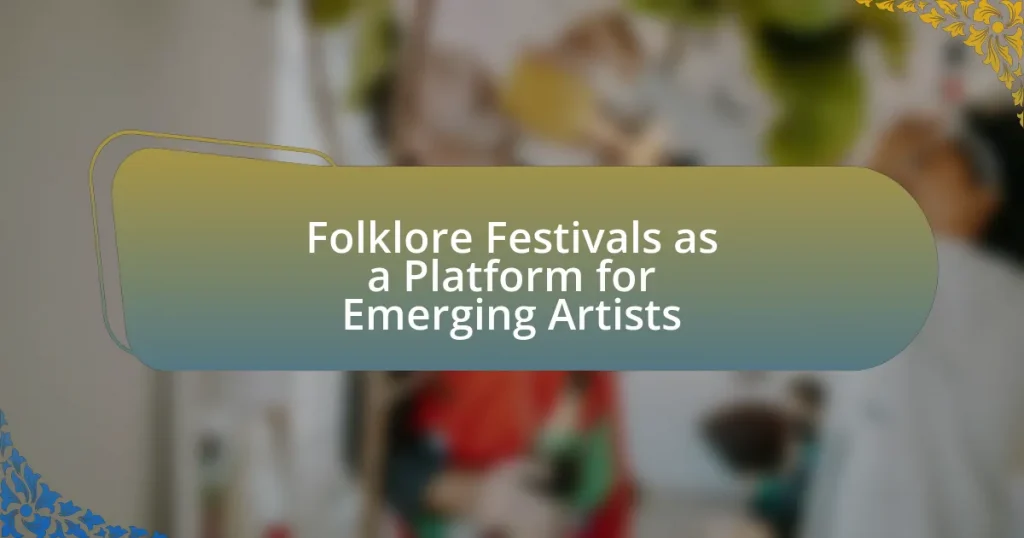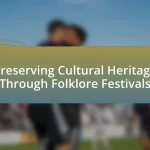Folklore festivals are cultural events that celebrate traditional music, dance, crafts, and storytelling, serving as vital platforms for emerging artists to showcase their talents and connect with audiences. These festivals play a crucial role in preserving cultural heritage by promoting traditional arts and facilitating intergenerational knowledge transfer. They provide opportunities for networking, exposure, and skill enhancement through performances, workshops, and mentorship programs. However, emerging artists face challenges such as competition from established acts and financial constraints, which can hinder their participation. The article explores how folklore festivals support artist development, the types of cultural expressions showcased, and best practices for maximizing the festival experience.
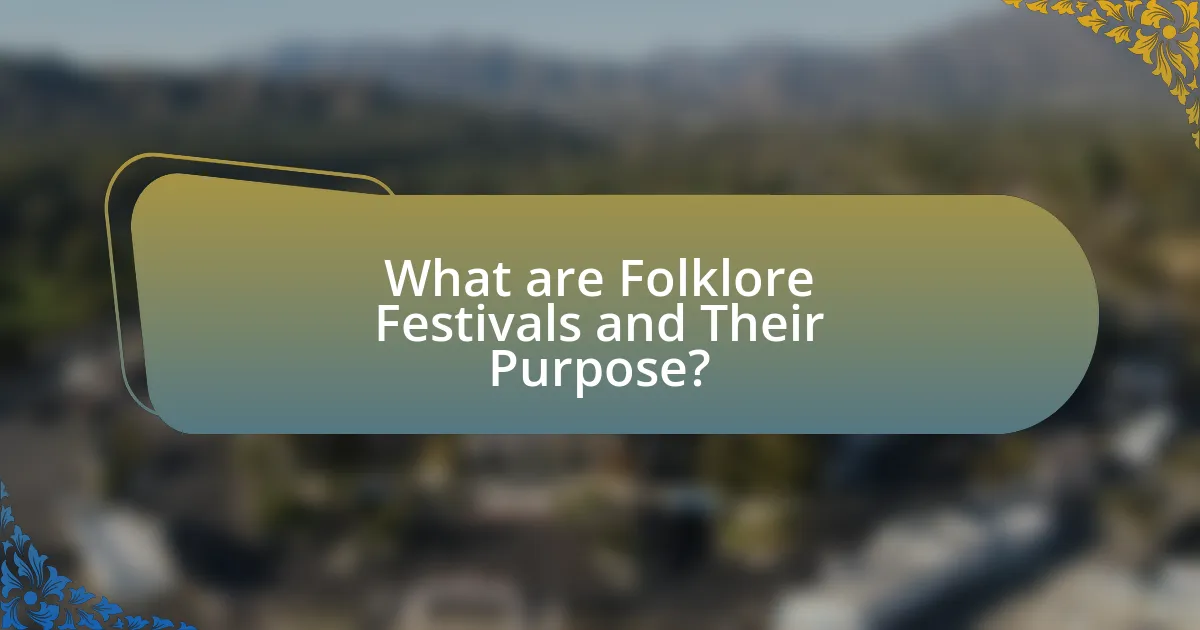
What are Folklore Festivals and Their Purpose?
Folklore festivals are cultural events that celebrate traditional music, dance, crafts, and storytelling, often reflecting the heritage of a specific community or region. Their primary purpose is to preserve and promote cultural traditions, allowing communities to share their unique identities with a broader audience. These festivals serve as platforms for emerging artists to showcase their talents, connect with audiences, and gain recognition within the cultural landscape. For instance, events like the National Folk Festival in the United States highlight local artists and provide opportunities for them to perform alongside established acts, fostering cultural exchange and artistic growth.
How do Folklore Festivals support cultural heritage?
Folklore festivals support cultural heritage by providing a platform for the preservation and promotion of traditional arts, crafts, music, and dance. These festivals often feature performances and exhibitions that showcase the unique cultural practices of specific communities, allowing participants to engage with their heritage actively. For instance, the Smithsonian Folklife Festival in the United States highlights diverse cultural expressions, fostering understanding and appreciation of various traditions. By facilitating intergenerational knowledge transfer, folklore festivals ensure that cultural practices are passed down, thereby sustaining the identity and continuity of communities.
What types of cultural expressions are showcased at these festivals?
Folklore festivals showcase a variety of cultural expressions, including traditional music, dance, crafts, storytelling, and culinary arts. These festivals serve as platforms for emerging artists to present their work, often highlighting regional customs and heritage. For instance, traditional music performances may feature local instruments and styles, while dance showcases regional choreography and attire. Additionally, artisans display crafts that reflect cultural significance, and storytelling sessions convey historical narratives and folklore. Culinary arts are also represented, with local dishes that embody the region’s culinary traditions.
Why is preserving folklore important for communities?
Preserving folklore is important for communities because it fosters cultural identity and continuity. Folklore serves as a repository of shared values, traditions, and histories that bind community members together, enhancing social cohesion. For instance, studies show that communities with strong folklore traditions often exhibit higher levels of community engagement and resilience, as these narratives provide a sense of belonging and purpose. Furthermore, folklore can stimulate local economies through cultural tourism, as festivals celebrating these traditions attract visitors and promote local artisans. This economic benefit reinforces the community’s commitment to preserving its unique cultural heritage.
What role do Folklore Festivals play in the arts community?
Folklore festivals serve as vital platforms for emerging artists within the arts community by providing opportunities for exposure, networking, and cultural exchange. These festivals often showcase traditional and contemporary art forms, allowing new artists to present their work to diverse audiences. For instance, events like the National Folk Festival in the United States have historically featured local talent alongside established performers, fostering an environment where emerging artists can gain recognition and build their careers. Additionally, folklore festivals promote cultural heritage, encouraging the preservation of artistic traditions while simultaneously allowing new interpretations and innovations to flourish. This dual role enhances the overall vibrancy of the arts community, making folklore festivals essential for both artists and audiences.
How do these festivals provide exposure for emerging artists?
Folklore festivals provide exposure for emerging artists by offering them a platform to showcase their work to diverse audiences. These festivals often attract large crowds, including industry professionals, which increases visibility for new talent. For instance, events like the Newport Folk Festival have historically launched the careers of numerous artists by featuring them alongside established acts, thus facilitating networking opportunities and media coverage. Additionally, many festivals include competitions or showcases specifically designed for emerging artists, further enhancing their chances of being discovered.
What opportunities do Folklore Festivals create for networking?
Folklore festivals create significant networking opportunities by bringing together artists, cultural organizations, and audiences in a shared space. These events facilitate connections among emerging artists, industry professionals, and cultural enthusiasts, allowing for collaboration, mentorship, and exposure to new audiences. For instance, festivals often include workshops, panel discussions, and informal gatherings that encourage interaction and relationship-building. According to a study by the National Endowment for the Arts, participation in cultural festivals can enhance professional networks and lead to increased opportunities for artists to showcase their work and collaborate on future projects.
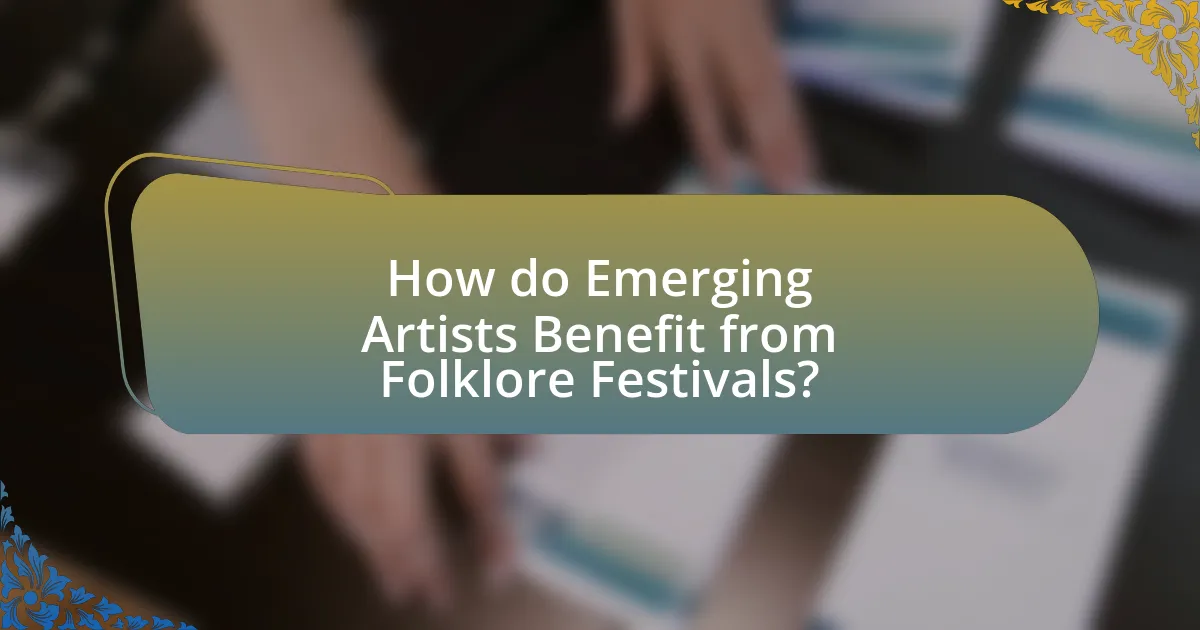
How do Emerging Artists Benefit from Folklore Festivals?
Emerging artists benefit from folklore festivals by gaining exposure, networking opportunities, and access to diverse audiences. These festivals provide a platform for artists to showcase their work, often leading to increased visibility and potential collaborations. For instance, participation in events like the National Folk Festival can connect artists with industry professionals and fellow musicians, enhancing their career prospects. Additionally, folklore festivals often attract large crowds, allowing emerging artists to reach audiences that they might not encounter through traditional venues, thereby expanding their fan base and increasing their chances of success in the competitive arts landscape.
What platforms do Folklore Festivals offer for showcasing talent?
Folklore festivals offer various platforms for showcasing talent, including live performances, workshops, and competitions. These festivals typically feature stages for artists to perform traditional music and dance, allowing them to reach diverse audiences. Additionally, workshops provide opportunities for emerging artists to learn from established performers and enhance their skills. Competitions often highlight new talent, giving artists a chance to gain recognition and potentially launch their careers. Such platforms are essential for promoting cultural heritage and supporting the artistic community.
How can emerging artists gain visibility through performances?
Emerging artists can gain visibility through performances by participating in folklore festivals, which provide a platform to showcase their talent to diverse audiences. These festivals often attract large crowds and media attention, allowing artists to reach potential fans and industry professionals. For instance, events like the National Folk Festival in the United States feature numerous emerging acts, offering them exposure that can lead to further opportunities such as bookings, collaborations, and increased social media following. Additionally, performing at these festivals can enhance an artist’s credibility and connect them with established artists, fostering networking opportunities that are crucial for career growth.
What types of workshops or mentorship programs are available?
Various workshops and mentorship programs are available at folklore festivals, focusing on skills such as traditional arts, music, dance, and storytelling. These programs often include hands-on sessions led by experienced artists, providing participants with practical knowledge and techniques. For instance, many festivals offer workshops in instrument making, folk dance, and cultural storytelling, which are designed to enhance participants’ understanding of their heritage. Additionally, mentorship programs pair emerging artists with established professionals in the field, facilitating guidance and networking opportunities that can significantly impact their artistic development.
Why are Folklore Festivals significant for artist development?
Folklore festivals are significant for artist development because they provide emerging artists with exposure, networking opportunities, and a platform to showcase their work. These festivals attract diverse audiences, allowing artists to reach potential fans and industry professionals. For instance, events like the National Folk Festival in the United States have historically helped launch the careers of numerous artists by connecting them with record labels and booking agents. Additionally, participation in folklore festivals fosters skill enhancement through workshops and performances, enabling artists to refine their craft in a supportive environment.
How do these festivals help artists refine their craft?
Folklore festivals help artists refine their craft by providing them with opportunities for live performance, feedback, and collaboration. These festivals create an environment where artists can showcase their work to diverse audiences, allowing them to gauge audience reactions and improve their presentation skills. Additionally, artists often engage in workshops and masterclasses during these events, where they receive guidance from established professionals, enhancing their technical abilities and artistic expression. Research indicates that participation in such festivals can lead to increased confidence and skill development, as artists learn from both peers and mentors in a supportive community setting.
What feedback mechanisms are in place for artists at these events?
Feedback mechanisms for artists at folklore festivals include audience surveys, artist feedback sessions, and social media engagement. Audience surveys collect direct responses from attendees regarding their experiences and perceptions of the performances, providing artists with insights into their impact. Artist feedback sessions allow performers to discuss their experiences with festival organizers, facilitating constructive dialogue about their performances and areas for improvement. Additionally, social media engagement enables artists to receive real-time feedback from audiences, fostering a dynamic interaction that can inform their future work. These mechanisms collectively enhance the development and visibility of emerging artists within the festival context.
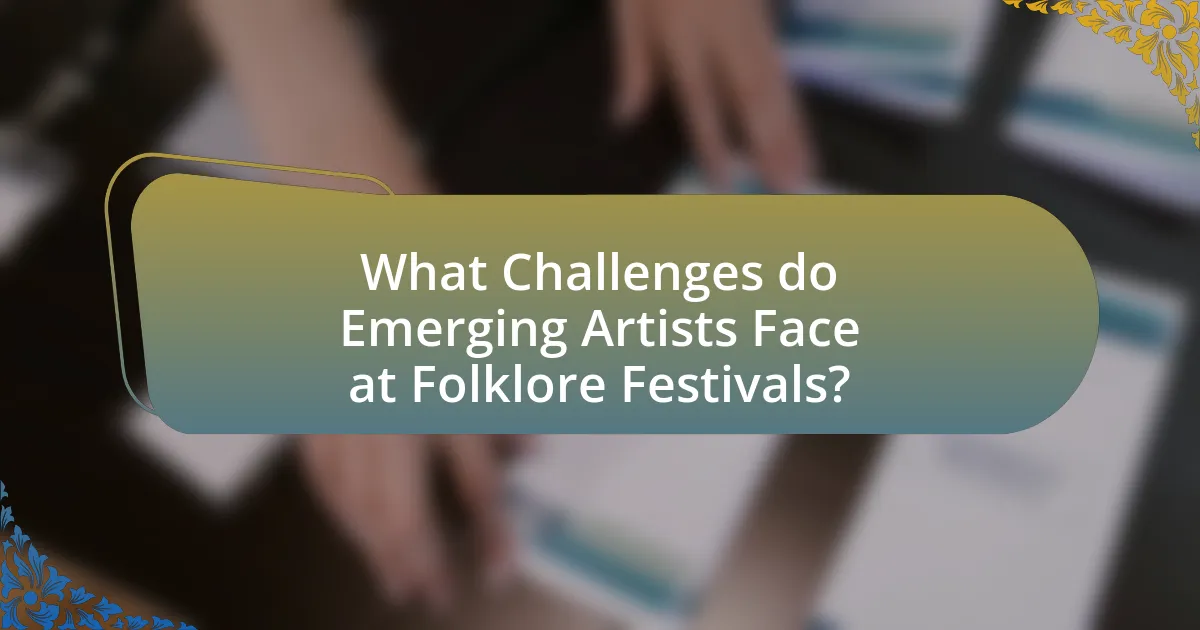
What Challenges do Emerging Artists Face at Folklore Festivals?
Emerging artists face several challenges at folklore festivals, primarily including limited exposure, competition from established artists, and financial constraints. Limited exposure occurs because many festivals prioritize well-known acts, making it difficult for new artists to gain visibility. Competition from established artists can overshadow emerging talent, as audiences often gravitate towards familiar names, reducing opportunities for newcomers to showcase their work. Financial constraints also pose a significant challenge, as emerging artists may struggle with the costs associated with travel, accommodation, and festival fees, which can hinder their participation. These factors collectively impact the ability of emerging artists to effectively leverage folklore festivals as a platform for growth and recognition.
What barriers exist for participation in Folklore Festivals?
Barriers for participation in Folklore Festivals include financial constraints, lack of awareness, and logistical challenges. Financial constraints often arise from high costs associated with travel, accommodation, and festival fees, which can deter emerging artists from participating. Lack of awareness about festival opportunities limits the ability of artists to engage, as many may not know about the festivals or how to apply. Logistical challenges, such as scheduling conflicts and inadequate support for artists in terms of resources or mentorship, further hinder participation. These barriers collectively restrict access for emerging artists seeking to showcase their work in Folklore Festivals.
How can emerging artists overcome financial constraints?
Emerging artists can overcome financial constraints by leveraging folklore festivals as platforms for exposure and networking. These festivals often provide opportunities for artists to showcase their work without the high costs associated with traditional galleries or venues. For instance, many folklore festivals offer grants, sponsorships, or performance fees that can alleviate financial burdens. Additionally, participating in these events allows artists to connect with potential patrons, collaborators, and audiences, which can lead to further financial opportunities. According to a study by the National Endowment for the Arts, community-based events like folklore festivals significantly enhance visibility and can lead to increased sales and commissions for artists.
What logistical challenges do artists encounter when performing?
Artists encounter several logistical challenges when performing, including scheduling conflicts, transportation issues, and technical requirements. Scheduling conflicts arise when multiple events overlap, making it difficult for artists to secure performance slots. Transportation issues can involve delays or difficulties in moving equipment and personnel to the venue, which can disrupt the performance timeline. Additionally, technical requirements such as sound and lighting setups often necessitate precise coordination, and any failure in these areas can impact the quality of the performance. These challenges are critical as they can affect not only the artist’s ability to perform but also the overall experience for the audience.
How can Folklore Festivals improve support for emerging artists?
Folklore festivals can improve support for emerging artists by providing them with performance opportunities, exposure to diverse audiences, and networking possibilities. These festivals often feature stages dedicated to showcasing local and emerging talent, allowing artists to gain visibility and experience in a live setting. For instance, the American Folklife Center reports that festivals can attract thousands of attendees, creating a platform where emerging artists can connect with potential fans and industry professionals. Additionally, many folklore festivals offer workshops and mentorship programs, further enhancing the skills and careers of these artists. By fostering an environment that celebrates cultural heritage and innovation, folklore festivals play a crucial role in the development and promotion of emerging talent.
What initiatives can be implemented to enhance artist participation?
To enhance artist participation in folklore festivals, initiatives such as providing financial support, offering mentorship programs, and creating platforms for collaboration can be implemented. Financial support can include grants or stipends specifically for emerging artists, which has been shown to increase participation rates in cultural events. Mentorship programs that pair experienced artists with newcomers can foster skill development and confidence, leading to greater involvement. Additionally, creating collaborative spaces where artists can work together on projects encourages networking and community building, which are essential for sustained participation in folklore festivals.
How can festival organizers better promote emerging talent?
Festival organizers can better promote emerging talent by implementing targeted marketing strategies that leverage social media platforms and local community engagement. By utilizing platforms like Instagram and TikTok, organizers can showcase performances, behind-the-scenes content, and artist interviews, which can significantly increase visibility and audience engagement. Research indicates that 54% of social media users prefer to discover new music through these platforms, highlighting their effectiveness in reaching potential festival-goers. Additionally, collaborating with local businesses and community organizations can create a supportive ecosystem that amplifies the reach of emerging artists, fostering a sense of community and shared investment in their success.
What are best practices for emerging artists at Folklore Festivals?
Emerging artists at folklore festivals should prioritize networking, performance quality, and audience engagement. Networking is crucial as it allows artists to connect with industry professionals, other musicians, and potential collaborators, which can lead to future opportunities. Performance quality is essential; artists should rehearse thoroughly and ensure their set is polished to leave a lasting impression on the audience. Engaging with the audience through storytelling or interactive elements enhances the overall experience and fosters a deeper connection. According to a study by the National Endowment for the Arts, artists who actively engage with their audience report higher satisfaction and increased opportunities for future performances.
How should artists prepare for their performances at these festivals?
Artists should prepare for their performances at folklore festivals by thoroughly researching the festival’s audience, culture, and expectations. This preparation involves understanding the specific themes and traditions associated with the festival, which can enhance the relevance and impact of their performance. For instance, artists can study past performances and audience reactions to tailor their act accordingly, ensuring it resonates with the festival-goers. Additionally, rehearsing extensively and incorporating elements that reflect the local culture can create a more authentic experience. According to a study published in the Journal of Arts Management, Law, and Society, artists who engage with the cultural context of their performance are more likely to receive positive feedback and foster connections with the audience.
What strategies can artists use to maximize their festival experience?
Artists can maximize their festival experience by actively engaging with the audience, networking with other artists, and promoting their work through social media. Engaging with the audience fosters a connection that can lead to increased support and fan loyalty, which is crucial for emerging artists. Networking with other artists allows for collaboration opportunities and sharing of resources, enhancing their visibility within the festival community. Promoting their work on social media before, during, and after the festival can significantly increase their reach, as studies show that artists who utilize social media effectively can gain up to 50% more followers during festival events. These strategies collectively enhance an artist’s presence and opportunities at folklore festivals, making them more impactful.










